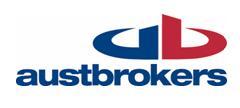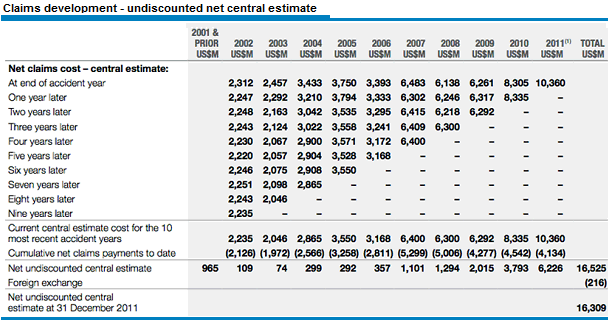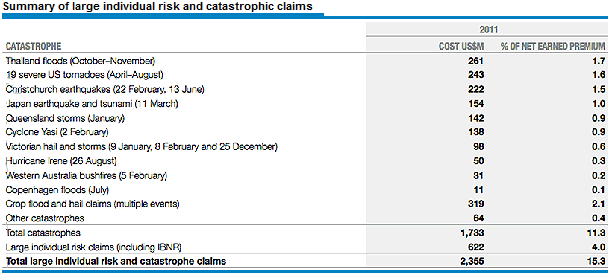Insurance
-

Quick Byte #2: Cover-More
Roger Montgomery
April 15, 2014
Following on from yesterday’s Quick Byte on the outcomes of the UBS Emerging Companies conference, today we’re taking a look at our analysts’ notes on Cover-More. continue…
by Roger Montgomery Posted in Insightful Insights, Insurance.
- 4 Comments
- save this article
- POSTED IN Insightful Insights, Insurance
-

A good deal?
Ben MacNevin
December 18, 2013
Insurance Australia Group (ASX: IAG) has offered Wesfarmers (ASX: WES) $1.845 billion to acquire its insurance division. Wesfarmers expects to record a pre-tax profit of $700 million on the transaction, but is the purchase just as lucrative for IAG? continue…
by Ben MacNevin Posted in Companies, Insurance.
- 2 Comments
- save this article
- POSTED IN Companies, Insurance
-

Better times ahead for listed insurers?
Tim Kelley
January 23, 2013

After an extended run of disappointing performance from Australia’s largest non-life insurers, there have more recently been some positive signs. Over the past 12 months IAG’s share price has increased to around $5 from around $3 and, more recently, the QBE share price has risen from around $10 to over $12, partly on the back of press reports that cost reduction initiatives are planned. In light of these developments, it may be appropriate to consider whether these businesses face a brighter future.
continue…by Tim Kelley Posted in Insightful Insights, Insurance.
- 1 Comments
- save this article
- POSTED IN Insightful Insights, Insurance
-

Steady as she goes
Ben MacNevin
December 10, 2012
Few Australian management teams and their boards have been successful over long periods of time in ‘rolling’ up businesses under one roof. Inevitably, too much is paid; they struggle to deploy systems to drive scale and efficiencies; and retaining key management becomes a key problem once their lock-in period expires. It’s why we are so cautious of business strategies that revolve largely around acquisitions to grow the business. While it is easy to ‘grow’ by simply purchasing another business’ earnings, unless the return on the equity employed remains stable or improves, such capital allocation decisions will erode shareholder wealth over time.
by Ben MacNevin Posted in Companies, Insightful Insights, Insurance.
- save this article
- POSTED IN Companies, Insightful Insights, Insurance
-
Is it time to buy QBE?
Roger Montgomery
March 15, 2012
 QBE shares are trading at their lowest price since 2007, and they’re trading at Skaffold’s estimate of Intrinsic Value. They could be a compelling investment if premiums rise, US bonds collapse (interest rates therefore rise) and return on equity improves.
QBE shares are trading at their lowest price since 2007, and they’re trading at Skaffold’s estimate of Intrinsic Value. They could be a compelling investment if premiums rise, US bonds collapse (interest rates therefore rise) and return on equity improves.The release yesterday of QBE’s 2011 financial results, along with news of its planned $500 million capital raising ($450 million of which has now been raised from institutional investors), reminded me that there are many investors who may not understand the machinations of an insurance company. With that in mind, I thought some practical help in this regard would benefit those investors trying to make a decision about whether the lowest prices in QBE shares since 2007 represent good value.
Insurance companies can generally be divided up into two main businesses: underwriting, which is the practice of writing and collecting premiums on insurance policies, and paying claims on some of them; and the investment of those premiums – also known as ‘float’ or reserves – for the benefit of the companies’ owners.
It may surprise you to know the insurance business is relatively easy to understand, if you think about it from your own perspective. You pay an insurance company money to cover you for the risk of something undesirable befalling you. The amount of money you pay to the insurance company is the premium. Thousands of customers do exactly the same thing but not all of them will make a claim on their insurance policy. So the company attempts to make a profit from collecting and aggregating the premiums, paying commissions and expenses to the staff and resellers who market the insurance policies and then paying some portion of those premiums back out in claims.
At any period in time, there are insurance policies just written, insurance policies about to mature and insurance policies anywhere in between – and some of them will receive claims against them. At any point in time there is a pool of money that can be invested. These represent the unclaimed premiums on policies that are yet to mature. The income or profits earned from investing this, as well as claimed and immature premium revenue, is the second source of an insurer’s profit.
Many investors find analysing a balance sheet and profit and loss statement challenging. Analysing the reports of an insurance company is made doubly difficult by the fact that insurance companies use unique language to report their results.
Typically, insurance company results are displayed in two ways: there is the underwriting result, which is the result that excludes investment returns, and the insurance result, which includes investment returns.
The first line of an insurer’s profit and loss statement is the gross written premium. This is the total amount of money the company received in the form of payment for insurance policies for that year.
Now you may recall I mentioned earlier that at any period in time there are insurance policies just written, insurance policies about to mature and insurance policies anywhere in between. There are different contingent liabilities associated with the time remaining to maturity of a policy and maturity of a policy does not always occur at the end of the company’s financial year. For that reason, when premiums are adjusted for the period to which remaining possible (contingent) liability exists, the adjusted revenue is referred to as the gross earned premium. Some insurance companies also report this number.
From your perspective, the total amount of premium you pay represents the gross written premium, but if you paid for your insurance policy two months before the end of the company’s financial year, then the gross earned premium would be the amount you paid adjusted for two months.
By subtracting reinsurance costs from gross written premium, the net written premium is produced. If timing adjustments or accrued adjustments for contingent liabilities are made at this point, the result is net earned premium.
To recap, net earned premium is simply the revenue from writing all policies, less reinsurance costs and adjusted for timing.
Subtracting claims and expenses from the net earned premium produces the underwriting result which, you may recall, excludes investment returns. Adding investment income on the float or reserves to the underwriting result produces the insurance result.
Without trying to confuse you, the insurance result does not include investment returns on the shareholder capital part of the business. The shareholder capital part of the business raises equity capital from the owners to meet capital adequacy or prudential regulation requirements and these funds may also be invested.
With a typical industrial business, we might assess its performance using the profit and loss statement and a variety of ratios, such as gross profit margin, net profit margin or EBIT margin. We can do the same thing with insurance companies, but the ratios are given different names.
If we divide the insurance result (think of the insurance result as the EBIT of the whole company) by the net earned premium (which you should think of as the net revenue), we produce the insurance trading result (ITR). The insurance trading result is like the EBIT margin in that it is a pre-tax number – it also excludes interest on any debt.
There are rough rules of thumb about what numbers like the ITR should be. One dollar of premiums can be supported by about $0.50 of equity. If the insurance trading result is 10%, then the result is equivalent to a 20% return on equity. And if an investor is seeking a 10% required return, the right price to pay for an insurer might be double their equity.
The loss ratio is the ratio of paid claims to the net earned premium during the year. By comparing the amount paid out to the amount received, it measures the insurance companies’ effectiveness in pricing and predicting insurance policies and claims.
The expense ratio measures the proportion of sales the company expended on overheads. It measures operating expenses by comparing them to premium income. It is an efficiency measure, much like the cost to income ratio used by banks.
Finally, the combined ratio: this is a measure of profitability of daily operations. A ratio below 100% indicates that the company is making underwriting profit, while a ratio above 100% means that it is paying out more money in claims that it is receiving from premiums.
The combined ratio is reported in the context of the underwriting and insurance profit. It combines the claims ratio and the expense ratio. Remember, the claims ratio is claims owed as a percentage of revenue earned from premiums. And the expense ratio is operating costs as a percentage of revenue earned from premiums. The combined ratio is calculated by taking the sum of both types of incurred losses and expenses (underwriting expenses, including commissions, as well as claims) and then dividing them by earned premium. In short, combined ratio is the amount that revenue was eroded by to leave the profit margin, and doesn’t include investment income.
QBE reported its combined ratio had risen from 89.7% in 2010 to 96.8% and attributed the increase to higher costs (reinsurance and claims) associated with more frequent catastrophes and a higher net present value of claims due to a lowered discount rate (thanks to historically low interest rates overseas).
Even if the combined ratio is above 100%, a company can potentially still make a profit, because the ratio does not include income received from investments.
At the risk of completely losing you, the profit reported by the insurance company is in many ways like the profit reported by an airline – it is an accounting construct. You see, the item labelled ‘claims’ doesn’t correspond to actual cash claims made. Instead, it is invented by the accountants and actuaries and infected by an adjustment to the reserves. If you think of the reserves or float – the aggregated premiums received – as a liability or an amount set aside to cover future claims, then the claims item is an estimate based on current rates and the costs of those claims. As reported by QBE in its 2011 results this week, it is also impacted by changes to discount rates.
Table (E) on page 129 of QBE’s just-released annual report displays the adjustments made to the company’s flood or reserves as a result of a change in these estimates. The change to the reserve (you can see this by running your eye down a column) has an impact on the reported profit through the claims item in the profit and loss statement. For example, in 2004 the reserve changed from $3.4 billion at the end of the year of accident to $2.8 billion seven years later. This is a net benefit of $600 million to profits over that period. In the 2011 QBE result, an amount of $US64 million has been reported as “saving on prior year central estimate”.
Armed with this information, you are now a few steps closer to appreciating QBE’s results.
In 2011, QBE produced an underwriting profit of $US494 million compared to $US1.2 billion in 2010. QBE’s gross written premium (the total amount of money the company received in the form of payment for insurance policies for that year) rose 34% to $US18.3 billion, thanks in no small part to acquisitions. Net earned premium income (the gross profit after reinsurance and adjusted for timing) rose 35% to $US15.4 billion. Large individual risk and catastrophe claims amounted to 15.3% of net earned premium versus 9.5% in 2010 (see table).
The large number of painful hits to the company from these events have made it somewhat gun shy and it has pulled back some of its business lines in regions where reinsurance is too expensive. This may or may not be the right move. Only time will tell.
The insurance profit margin (contribution to profit from underwriting and investment income as a percentage of net earned premium) fell to 7.1%, compared with 15% in 2010.
The inefficiency of the stockmarket, however, was revealed when the company said its results were in line with the guidance it gave in January. In that trading update, the company gave guidance for all the above ratios, but analysts were left to translate the ratios into a net profit after tax figure. As at Monday this week, that translated consensus profit figure was $A936 million and 84 cents per share.
Yesterday, with its shares in a trading halt, QBE’s net profit came in at $US704 million ($A657 million) and EPS of $US0.61 cents per share ($A0.57 cps). The company also announced a capital raising through a bookbuild with a $10.50 floor, to raise $500 million, replacing Tier 2 convertible debt that under new APRA guidelines cannot be regarded as regulatory capital. This will dilute next year’s earnings.
You can see from the graph below that the reason for QBE’s terrible share price performance since 2007 is the fact that returns (the blue line) on ever increasing equity (the growing grey columns) have fallen from 26% in 2007 to less than 8% in 2011.
If, with your newfound understanding of the insurance business, you are interested in buying QBE at the lowest prices since 2007, then you need to be confident that the return on equity will begin to rise to levels that are materially above those available in a relatively risk-free bank account. And for this to happen, premiums will need to seriously pick up while claims remain low and nature stays quiet for a while.
Posted by Roger Montgomery, Value.able author, Skaffold Chairman and Fund Manager, 15 March 2012.
by Roger Montgomery Posted in Companies, Financial Services, Insurance.
- 19 Comments
- save this article
- POSTED IN Companies, Financial Services, Insurance
-
Just a little patience… is that all QBE needs?
Roger Montgomery
August 5, 2010
Turn on the TV, your computer or Mail on your iPhone and you are inevitably bombarded with news and data. And if you are following the financial markets, there is no shortage of headlines to grab your attention.
Take QBE’s recent profit downgrade and how the media bided for your attention; “QBE savaged after downgrade” and “QBE’s worst storm”. I bet amid all this news you missed IAG’s conveniently-timed announcement, the very next day; “IAG tips profit to be halved”.
There is a good reason for such bleak headlines… bad news sells.
Money is a very personal asset. We spend our lives working hard to earn it, make sacrifices to save it and when we invest it, some watch it like a hawk. These headlines rely on your strong ties to it. The by-product of course is that driven by emotions, the headlines create activity, which means transactions and remuneration, in turn funding advertising and marketing, fuelling more headlines.
Those waiting for good news from QBE might feel a little like Guns N’ Roses frontman Axl Rose when he penned the band’s 1988 hit ‘[need a little] Patience’. But it is patience that is the hallmark of the world’s best investors. So let’s focus on the long-term.
QBE’s recent profit downgrade was driven by falling investment income on its ‘float’, not a broken business model as the media headlines might suggest. Sure new equity issuance, the rising Australian dollar and sharp declines in global interest rates have conspired to depress QBE’s earnings and profitability, but the investment community’s current focus on movements in QBE’s investment income is likely to be short-term. Invariably the incessant focus on cause and effect relationships will switch to something else. It may even turn 180 degrees.
Over 90% of QBE’s investment portfolio (US$20b) is held cash and cash-like investments (highly liquid). These are currently depressed by low interest rates and lower foreign currency gains. This will be mitigated in the future as QBE moves from $AUD to $US reporting. And keep in mind that some very successful investors believe bonds are in a bubble. If thy’re right and the bubble bursts, yields will rise. (don’t ask me what I think, I don’t forecasts markets or the economy).
The remaining 10% of the insurer’s investment portfolio is in equity markets and although the collapse in the Elders share price (in which QBE has a strategic holding) may be a more permanent situation, other holdings should recover or emerge to offset the losses in time.
Looking through the headlines, QBE’s core insurance business continues to perform well. With industry-leading Combined Ratios and Insurance Margins, QBE has cemented itself in a position that is well ahead of its Australian competitors. This is what investors should be focusing on.
The remaining issue is the intrinsic value. The current value has fallen by a couple of dollars and the lower profits means the equity in the business will now grow more slowly. This has the effect of reducing future intrinsic values as well. QBE however was only trading at a small discount previously, not the very large discounts that I seek. The current valuation declines indicate that only small discounts to intrinsic value exist now so be sure to discuss that with your advisor.
QBE’s investments will inevitably rise and fall with the markets in which it invests, but making a profit on its underwriting business means the float represents very cheap funds. Throw in industry-leading management and the long term prospects remind me of what its like to take off in a plane during a storm.. .only to discover the sky is blue above the clouds.
Posted by Roger Montgomery, 5 August 2010.
by Roger Montgomery Posted in Insurance.
- 42 Comments
- save this article
- POSTED IN Insurance
-
QBE – Does it eat twisters and floods for breakfast?
Roger Montgomery
June 11, 2010
In March this year I shared my insights about QBE with readers of Alan’s Eureka Report. Since that time QBE’s share price has fallen from over $22.00 to $19.00 – a decline of around 15%. That may explain why I have received a few requests asking for an updated estimate for QBE’s value?
If you take your cues from price action, you would probably conclude something might be wrong with the company.
Open up a newspaper, flick on the TV, or do both on your new iPad and you will be overwhelmed with the events in the US, the debacle that is the Euro zone, and BP’s oil spill – one of man’s greatest catastrophes.
With 40% of gross written premiums being derived in the US and a further 40% from London and Europe, it is likely QBE is exposed, somewhere.
Even at home the company appears to be right in the firing line of the Lennox Head twister, Victoria’s bushfires and recent floods.
It’s not all bad news though – the declining Australian Dollar ensures QBE’s overseas earnings are now worth more.
So is there something wrong at QBE? Or is the market just reacting to bad news? Buffett says you pay a high price for a cheery consensus, so maybe bad news is just what’s needed to make QBE attractively priced…
You have to remember that QBE is in the business of forecasting and betting against bad news – it exists to manage risk and spread it around when there is too much for it to shoulder alone. And given its successful decade-long track record of doing so, I can strongly argue that it performs this activity significantly better than many, if not most, of the other insurers listed on the ASX.
Things that you and I perceive as negatives are usually positives for insurance companies. Think of the last time you had to make an insurance claim. Did your premium rise the next time you chased around for a better price?
In March this year a sensible price to pay for QBE was $19.83. Now a sensible price is $19.92. So even with all the negative news and natural disasters, the only thing that appears to have changed is the market price.
The truth is that the business operations that make up QBE’s brand have been moving much slower than its share price would suggest, and the rising valuation suggests things are believed to be improving.
While the price was well above the estimated valuation three months ago, I couldn’t have predicted the share price would fall below it.
I did say that “With a gun to my head and forced to make a decision, I would bet with Frank O’Halloran at QBE every time”. That remains the case today.
I do get excited when the market, in its wisdom, decides that it temporarily dislikes great businesses. The result is a fall in the share price. Who doesn’t like to buy more of a good thing for less? The price however may not have declined far enough to provide the sort of Margin of Safety Ben Graham said should be required in Chapter 20 of his Intelligent Investor – arguably one of the two most important teachings in investment history.
There are a bunch of insurance businesses listed on the ASX. Some are pure insurers and some have insurance divisions within the business. I am interested to hear what you think of any of them. Have you had to deal with them and have you had a good or not so good experience? Do you work in the industry? Can you shed some light on who you think is the best and why? Share your thoughts by clicking Leave a Comment below. AND REMEMBER – YOU MUST OBTAIN PERSONAL PROFESSIONAL ADVICE BEFORE CONDUCTING ANY TRANSACTION OF ANY KIND IN ANY SECURITY IN THE MARKET.
Posted by Roger Montgomery, 11 June 2010.
by Roger Montgomery Posted in Companies, Insightful Insights, Insurance.
-
Is AMP getting good value for Axa and could ANZ really pay that much for AMP?
rogermontgomeryinsights
November 23, 2009
Corporate Australia has a rich history of overpaying for the right to be big, bigger, the biggest. While size may help fatten the wallet of the steward steering the ship, it is often the case that investors, particularly those late to the party, see their wallets lose weight.
When ABC Learning bought all those centres and Wesfarmers bought Coles, it was obvious that the prices being paid were much higher than a rational and patient value investor would pay. Justified with promised synergies however, many acquisitions can be made to look good, disguising the real he’s-got-one-so-I-want-one-too motivation.
Turning to the AMP/Axa deal I should first point out that I am not suggesting either company is in the same boat as ABC Learning. What I will say though is that ultimately a business is worth some multiple of its equity and that multiple must be related to its profitability. Talk surrounds the possibility that Axa could be the recipient of another bid – although none has been forthcoming and with wealth management being a key growth strategy for the banks, there is also talk that ANZ might bid for AMP. The hunter becomes the hunted. Ignoring the cliches, the rumours and share price gyrations, we can value Axa and decide whether we like AMP management’s capital allocation strategy. We can also value AMP and decide, if ANZ make a bid, what we think of them.
Turning first to Axa; AMP has, with cash and shares, bid about $5.40 per share. Unsurprisingly Axa shareholders want a higher bid. Well of course they do. I would rather receive a few million more for my house too. But Axa’s performance doesn’t justify a higher bid and AMP needs to be prudent. According to analyst estimates of EPS, Axa will generate a return on equity of about 13 percent over the next two years. With the exception of the 2008 loss, the return on equity for the last ten years has ranged between 6.8% in 1999 and 27% in 2003. Based on the forecast ROE and a payout ratio of between 61% and 67%, Axa’s 2010 equity of $2.58 per share is worth a little more than $3.00 per share. The market believes AMP will bid more and so the shares are trading at $5.84.
With AMP at $6.35 – up from its lows earlier this year of $3.52 – the price does not reflect the actual value of the business which is between $4.53 and $5.24. Should ANZ bid even more than the already optimistic price, it would reflect a genuine me-too strategy over at ANZ.
Nothing gets the blood racing more than a takeover and when blood leaves the head for other regions, common sense usually follows.
By Roger Montgomery, 23 November 2009
by rogermontgomeryinsights Posted in Financial Services, Insurance.
- 4 Comments
- save this article
- POSTED IN Financial Services, Insurance
- 1
- 2



